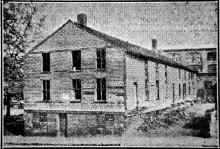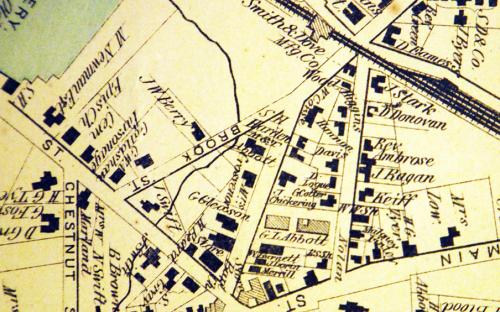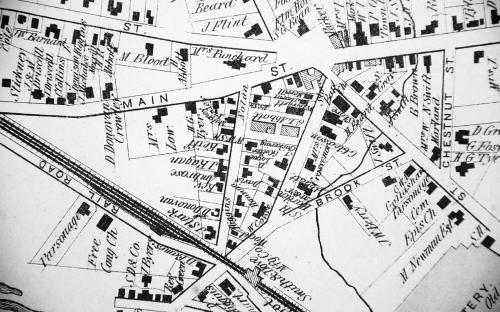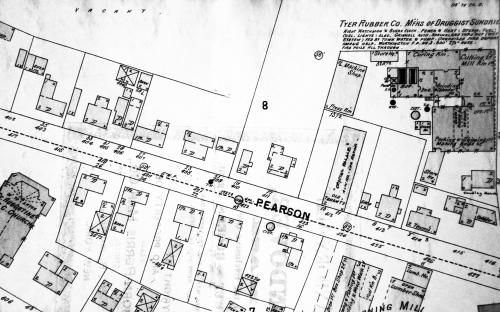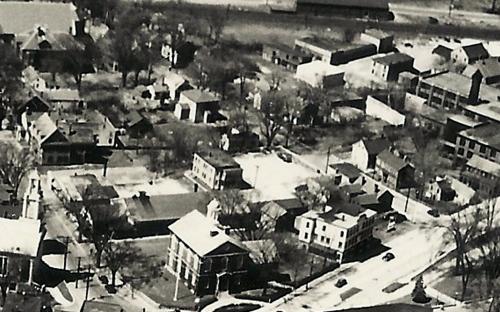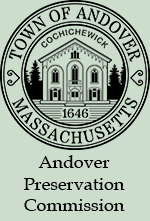Architectural Description:
Greek Revival building
Historical Narrative:
11 – 13 Pearson St. “Crystal Palace” lot was 200’ from corner of Main & Pearson St. S 82’ on Pearson St. x N 114’ x E 78’ x S 114’
On March 15, 1833 a charter from the Legislature was given to Andover business men Hobart Clark, Abraham Marland, Amos Abbot, John Smith and Merrill Pettingill to build the Andover & Wilmington Railroad line. In June 1833 the company capital stock of 1000 shares at $100 a share. Construction began in the spring of 1835 when the Boston & Lowell line was nearing completion.
The Andover line extended from North Wilmington nearly eight miles through Lowell Junction, Ballardvale near South School, the Andover Recreation Park, Spring Grove Cemetery, down the south sides of Abbot and Central Streets, across School St. then turning at the location of St. Augustine’s School to the Depot on Essex St., now the site of the rear addition of Memorial Hall Library. The terminus for the line was the current site of the Public Safety Center. It would later be extended to Haverhill, via Hartigan Court and High St. to Waverley Rd. in North Andover. By February 1843 it had reached South Berwick Maine a total of 58 miles.
Two large buildings were built on the north side of Pearson St. in 1835. A brick barn like structure called the Engine house for iron work and mechanical repairs and a long wooden shop for construction and repair of railroad cars. This would later become known facetiously as the “Crystal Palace”. The freight buildings were located between Essex & Pearson Streets now most of the library parking lot.
Nathaniel Whitter, a master carpenter, “was superintendent in charge of the repair and car shop for a year with M. Christopher Andrews, his successor, then just 19 years of age, as foreman. He had 75 men under him, most of the time; carpenters, painters and blacksmiths.” Andrews would become a master car builder and lived nearby at 43 Essex St. now the site of St. Augustine’s Church.
The first rail cars were pattern after the Concord Stage Coaches of that time. They had four steel wheels, were 14 ft. long and 7 ft. wide and too low to stand upright in. The cars were divided into two sections with two benches holding five passengers each facing each other, total 20 to a car. This design was later modified to about two feet longer, the partition was removed and the seats rearrange to accommodate 25 with a small aisle in the middle.
On June 6, 1835 Andrews walked the track from Andover to Wilmington Junction checking the sleepers and rails. At Lowell Junction he met the new train, the engine named “Andover” with two new cars. Andrews hopped on board and became the first passenger to ride into Andover on a steam railroad. When the train arrived in town, the bank hill where the Enterprise Bank in located was “black with people, standing as thick as they could; in fact, nearly the whole town had turned out when they heard that the first train was coming into Andover that morning.” It was finally opened to the public on August 8, 1836.
The Andover - Wilmington Railroad became the Boston & Maine Railroad and functioned for 12 years at this location. On March 3, 1846 approval was obtained to relocate the rail line west to the current route to service the new city of Lawrence. It took two years to build and opened on July 3, 1848. The B & M Railroad then sold off the former properties of the Andover – Wilmington line. The Engine house and turntable was relocated to South Lawrence.
Herman Abbot Jr. purchased the Car Shop building on July 7, 1851 for $480.30. Herman Abbot Jr. was a cabinet and furniture maker. He was also an undertaker with his brother Joseph and made caskets. He lived at 16 High St. in the family home with his father Herman, and sister Lydia. Herman converted the large building into a tenement building, using part of the building for his business as a Storehouse & Painting Shop and renting out the rest as apartments. It is during his ownership the building became nick-named the Crystal Palace. Herman then moved the showrooms to Elm Sq. now the site of Memorial Hall Library.
June 15, 1854 AA - Removal – Herman Abbott, Jr. has removed his furniture shop to the corner of Main & Essex St. opposite the P.O. Sept. 9th
Oct. 27, 1855 AA – Herman Abbott, Jr. Manufacturer and dealer in Cabinet Furniture – large ad. – Ware rooms opposite the Post Office
.Sept. 18, 1868 AA The Furniture ware rooms of Herman Abbott will be auctioned off on Saturday the 19th – household goods. [Essex & Main Street – Elm Square]
Sunday morning May 29, 1870 a fire completely destroyed the entire block from the corner of Pearson Street south to Elm Square and the corner of Essex Street.
“The fire next reached the wooden buildings of Herman Abbot, on the corner. and they with a portion of their contents, were entirely destroyed. The buildings were occupied by the owner for coffin and picture framing rooms, and by Joseph Abbott, as a residence, and for furniture ware rooms. The principal part of the furniture and other articles were saved, although a large number of coffins, caskets, and fixtures were lost.
The dwelling house of Mrs. Edward S. Merrill, on Essex Street, was almost wholly destroyed, the bare walls only remaining…..”
April 5, 1870 AA – Town got a pledge of $25,000 from John Smith to build Memorial Hall if the town will match and purchase the Herman Abbott lot on the corner of Essex and Main Street – former site of Joseph Abbott’s shop.
Sept. 2, 1870 Town is negotiating with Herman Abbott to purchase lot at Main & Essex Street- 11,675 square feet, price asked #3930. 3200 sq. feet will be cut off to straighten the street.
Sept 16, 1870 Herman Abbott sells his lot to John Smith for $3000. Mr. Abbott had commenced laying the foundation of a building upon the premises, but relinquished the undertaking for the sake of securing the erection of the “Memorial Hall” as a great public improvement.
Herman Abbott Jr. died the following year on Dec. 21, 1871 and his siblings, Joseph, Lydia and Benjamin F. Abbott became heirs of his estate. His sister, the eldest, was given life tenancy in the family home on High St. which was given to the American Missionary Association of NYC. His brother Joseph relocated to the Derby-Valpey building at 2 Main St.
Jan 26, 1872 AA p. 2 “Crystal Palace” on Pearson St. – The building known at the “Crystal Palace” on Pearson Street, owned by the estate of Herman Abbott, was discovered to be on fire Monday forenoon about 11 o’clock. The Steam engine “Andover” was early on the ground, and very soon suppressed the flames. The reservoir on Pearson Street was soon exhausted and the hose was removed to the one on Essex Street, a few rods distant. The building was occupied by Thomas D. Black, s a wheelwright’s shop and for tenements by John Conley, Frank Williams, Michael Hurley, and the Widow William Welsh, and for a work shop and coffin storage by Mr. Abbott. A sick woman was removed upon a bed, and the furniture of the families residing in the building and the neighboring dwelling houses, was carried onto the street and to other places of safety. The entire building would have been destroyed by a few moments delay, and the houses and other buildings in immediate vicinity would have been greatly endangered. The fire was first discovered in the basement, but the cause is unknown. Damage not large. It is understood that there was no insurance. The Marland engine company were promptly on hand and rendered efficient service. [11-13 Pearson St - parcel 3]
July 19, 1872 AA “Crystal Palace” sold at auction on Saturday last to John Regan for $1575, formerly of the late Herman Abbott.
The building and land was deeded to Margaret Regan, wife of John O. Regan on Aug. 1, 1872. Seven years later the deed is transferred over to John O. Regan on Jan. 28, 1879. John Regan died in 1887 and his estate was administered by Daniel R. Regan & Wm P. Regan on Feb. 12, 1888. The property remained with the Regan family for 61 years. William P. Regan took sole possession on Jan. 29, 1895. The Chrystal Palace remained tenements for much of their ownership. The building gradually fell into disrepair and during the Depression the building was finally razed. The Tyer Rubber Company purchased the lot on Jan. 31, 1933. The deeds states “all land formerly known as Chrystal Palace.
Bibliography/References:
Essex County Registry Deeds, Salem, MA
Essex Northern Registry Deeds, Lawrence, MA
Andover - Wilmington Rail Road history - 1835-1848
Boston & Maine Railroad - 1848 - 1855
Andover Advertiser - Andover Townsman
M. Christopher Andrews - Biography & Obituary
Nathaniel Whittier Obit.
Lawrence Eagle Tribune - May 25, 1931 - Historic Andover Railroad Repair Shop Soon to Pass Into History
Owners;
Boston & Maine Railroad –
Herman Abbot Jr. – July 7, 1851 – b. 455 leaf 283 - $480.30 – w/blds
Joshua Abbot – Apr. 9, 1855 – b. 510 leaf 75 - $1500
Herman Abbot Jr. – June 16, 1856 – b. 534 p. 43 - $1500
Herman Abbot estate, Dec. 21, 1871 - heirs – Joseph, Lydia, & Benj. F. Abbot (t)
Margaret Regan, wife of John O. – Aug. 1, 1872 – b. 17, p. 261 w/lease to Thomas Black to 2/19/73
Newton P. Frye – Jan. 28, 1879 – b. 54 p. 168 – deed transfer parcel #3
John O. Regan – Jan. 28, 1879 – b. 54 p. 169
John Regan estate, Extrs. Daniel R. & Wm P. Regan – Feb. 12, 1888 – Probate
James Murphy – Jan. 24, 1895 – b. 444 p. 275
William P. Regan – Jan. 29, 1895 – b. 444 p. 277
William P. Regan estate, John Taylor Extr. – June 21, 1923 – Probate
Tyer Rubber Company – Jan. 31, 1933 – b. 569 p. 65 – all land formerly known as Chrystal Palace
Inventory Data:
| Street | Pearson St |
| Place | Andover Center District |
| Historic District | Not Applicable |
| Historic Name | Crystal Palace |
| Source | ECRDS, ENRDL, style-njs |
| Architectural Style | Greek Revival |
| Foundation | stone/granite/brick |
| Wall/Trim | clapboards/wood |
| Roof | asphalt - gable |
| Major Alterations | Conversion to an apartment building in 1851 |
| Condition | razed 1931 |
| Acreage | .025 acre |
| Setting | residential/commercial |
| Map and parcel | 38-10 |
| Recorded by | James S. Batchelder |
| Organization | Andover Preservation Commission |
| Date entered | May 16, 2017 |
